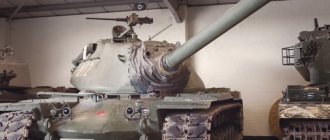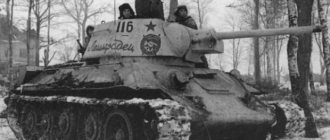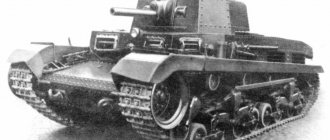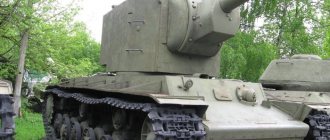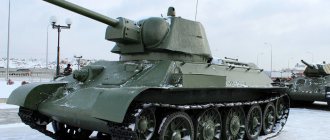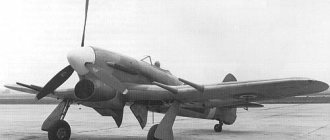What is the IS-3 - a Soviet heavy tank developed during the Great Patriotic War, launched into mass production in its last days and not having time to take part in it. Therefore, this combat vehicle is often considered one of the first post-war Soviet tanks. The abbreviation IS means “Joseph Stalin” - the official name of the series of Soviet heavy tanks produced in 1943-1953. Index 3 corresponds to the third production model of the tank of this family. Due to the characteristic shape of the upper frontal part of the hull, it received the nickname “Pike”.
Tank Is-3 - video
The creation of a project for a new heavy tank, code-named “Kirovets-1,” began in the late summer of 1944. The first experimental batch of IS-3 heavy tanks left the factory floor in May 1945. The gun was equipped with a two-chamber muzzle brake and a horizontal wedge breech with semi-automatic mechanical type. Rate of fire 2-3 rounds/min. The gun's ammunition consisted of 28 separately loaded rounds, including 18 with high-explosive fragmentation shells and 10 with armor-piercing shells. On the roof of the turret, on the turret, there was an anti-aircraft 12.7-mm DShK machine gun. Cruising range - 340 km. The IS-3 tank was in serial production until mid-1946 (in 1945, for some time, together with the IS-2). The IS-3 entered service with the heavy self-propelled tank regiments of the Soviet Army.
When developing the project for the IS-3 tank, the conclusions of the commission were taken into account, which examined combat damage received by tanks during the Battle of Kursk in front-line conditions. The massive damage to the frontal elements of the hull and turret was noteworthy. Therefore, it was decided to develop a new design for the turret and hull on the basis of the IS-2 tank to give them a streamlined shape and sharply differentiate the armor protection. As a result of the design work, the inclination of the welded sheets, especially in the front part of the hull, was brought to the maximum possible. Thick 110-mm plates of frontal armor were positioned in such a way that a three-slope, cone-shaped, elongated forward bow was formed, called the “pike nose.” The hatch was placed in the roof above the driver, which was not the case in the IS-1 and IS-2 tanks. There was no longer a need for a through viewing slit in the frontal armor in front of the driver - it was replaced by periscope viewing devices. New structural forms of armor provided better protection against projectiles. The new, flattened turret design was subsequently used in both the IS-7 and T-10, and also provided significantly better projectile resistance compared to previous turret designs installed on Soviet tanks.
Modifications
IS-3M - a modernized version of the IS-3.
IS-3K is a command version of the IS-3 tank, equipped with an additional R-112 radio station and an AB-1-P/30 charger.
IS-3MK is a command version of the IS-3M tank with the same equipment as on the IS-3K.
Design
The IS-3 had a classic layout, with the engine and transmission compartment located in the rear, the control compartment in the front, and the combat compartment in the middle. The tank's crew consisted of four people: a driver, a gunner, a loader and a commander.
Armored hull and turret
The IS-3 had powerful and highly differentiated armor protection (for its time in 1945), located at optimal angles of inclination and designed, first of all, to protect against fire from the most powerful modern tank and anti-tank guns in the frontal plane and from fire from most tank guns. and anti-tank guns - primarily from the German 88-mm rifled tank guns 8.8 cm KwK 43 and 7.5 cm KwK 42, and at the same time provided virtually complete protection from the most common towed 75-mm anti-tank guns 7.5 cm Pak 40.
The armored hull of the tank was assembled by welding from rolled sheets of homogeneous armor steel with a thickness of 20, 30, 60, 90 and 110 mm. The frontal armor of the tank was made of armor plates 110 mm thick according to the pattern known as the “pike nose”, and consisted of two left and right upper plates that converged like a wedge, located at an inclination of 56° to the vertical and with a turn of 43°, a lower plate located at an angle 63°, and the roof of the control compartment, located at an angle of 73°. Each of the sides of the hull consisted of two armor plates 90 mm thick: the upper one, located at an angle of 60° and forming a side niche, and the vertical lower one. In addition, the upper part of the sides was covered with 30-mm screens located at an angle of 30°, along with unarmored fenders, which formed additional side niches, accessed from outside the tank. The rear part was assembled from 60-mm armor plates: the lower one, located at an angle of 41°, and several upper ones, which had an angle of 48°. The roof of the hull was made of several 20 mm armor plates. The bottom of the hull, flat in the area of the transmission compartment and “trough-shaped” in the rest of the hull, was stamped and also made of 20-mm armor plate.
The IS-3 turret was a one-piece shaped casting made of homogeneous armor steel and had a nearly flattened hemispherical shape, teardrop-shaped in plan. The thickness of the turret walls at the sides and rear ranged from 220 mm at the bottom to 110 mm at the top, while in the frontal part it reached 255 mm. In general, the tilt angles, ranging from −8° to 35°, were selected in such a way that at any point on the tower walls their horizontal thickness was at least 160 mm. In the front part of the turret there were embrasures for a gun and a coaxial machine gun, covered by a cast armored mask attached to the gun barrel, the thickness of which reached 250 mm.
Armament
The main armament of the IS-3 was a 122-mm rifled tank gun D-25T model 1943, which had a barrel length of 48 calibers / 5852 mm and an initial armor-piercing projectile speed of 800 m/s. The D-25T gun had a horizontal wedge breech with semi-automatic mechanical type, electromagnetic and mechanical triggers. The gun's recoil devices consisted of a hydraulic recoil brake and a hydropneumatic knurler, located above the gun barrel on the left and right, respectively. The gun was mounted in the front part of the turret on trunnions in a coaxial installation with a machine gun, which allowed it to be aimed in a vertical plane using a sector-type mechanism in the range from −3 to +20°.
The twin installation was aimed at the target using a telescopic articulated sight TSh-17, which had a magnification of 4× and a field of view of 15°. In addition, for firing from closed positions, the gun was equipped with a side level and an azimuth indicator.
The gun's ammunition consisted of 28 rounds of separate-case loading with armor-piercing and high-explosive fragmentation cannon steel long grenades. Of the shells, 25 were placed in trays on the sides of the turret, another 3 were on stands in the fighting compartment. Of the cartridges, 6 were placed in stowages on both sides of the driver, 4 were placed on the upper sheets of the hull fender liners, 5 were placed in stowage on the floor of the fighting compartment, the rest were placed in clamp stowages: two - on the partition of the engine compartment and another one - on the starboard side housings. Since high-explosive fragmentation shells were larger in size, only armor-piercing shells could be placed in 11 of the ammunition stowage locations.
The mount paired with the cannon housed a 7.62 mm DTM machine gun. The machine gun's ammunition capacity was 2,000 rounds: 1,200 with a light bullet, 200 with an armor-piercing incendiary bullet, and 600 with a tracer. Of these, 756 rounds were in 12 disc magazines of 63 rounds each, the remaining 1244 were stored in standard closures, not loaded into magazines.
On the roof of the turret, on a ring turret, there was a 12.7-mm anti-aircraft heavy machine gun DShK or DShKM, which had all-round fire at vertical angles from −4 to +84°. The machine gun was equipped with a K-8T collimator sight, designed to fire at air targets moving at speeds of up to 400 km/h at an altitude of up to 400 m. The machine gun could also be used for shooting at ground targets, but its use was associated with a significant risk for the shooter , which for this purpose had to rise waist-deep from the hatch from under the protection of the armor. In the stowed position, the machine gun was removed from the turret and secured on the right side of the turret. The machine gun's ammunition capacity was 300 rounds in 6 belts of 50 each. Of this number, 225 rounds were equipped with B-32 armor-piercing incendiary bullets, and 75 with BZT armor-piercing incendiary tracer bullets. Also in the crew compartment there were 25 defensive F-1 grenades or offensive RG-42 grenades and two 7.62 mm PPS-43 submachine guns and 1000 rounds of ammunition for them.
Surveillance and communications equipment
In non-combat conditions, the driver monitored the terrain from his hatch; in combat, he used the MK-4 periscope viewing device, a copy of the British Mk.IV, which provided all-round visibility. The device was designed to be easily removable and had to be removed before opening the driver's hatch cover. Tanks upgraded to the IS-3M standard also had the TVN-1 passive night vision device, which could be installed in place of the MK-4 or on a separate stand when driving with the hatch open. The driver's viewing instrument has also been redesigned, eliminating unnecessary all-round visibility from the driver's seat. The tank commander, gunner and loader also each had one MK-4 device, which was placed on the roof of the turret. When upgrading to the IS-3M standard, the commander's MK-4 was replaced by the TPK-1 binocular device, which was more suitable for this purpose, providing 1x or 5x magnification.
For external communications, the IS-3 had a simplex telephone-telegraph radio station 10RK-26, located in the tank turret to the left of the gun and equipped with a whip antenna 1 to 4 m long. 10RK-26 provided telephone communications at a range of up to 35-40 km from a standstill and 20-25 km on the go. For internal communication, a TPU-4-bis-F telephone tank intercom was installed on the tank for all crew members, connected to a radio station.
IS-3 tank rear view on Shikotan Island. Kuril Islands, Cape "Edge of the World"
Engine and transmission
The IS-3 was equipped with a V-shaped 12-cylinder four-stroke liquid-cooled diesel engine model B-11, which developed a power of 520 hp. With. The engine power system included four fuel tanks with a total capacity of 425 liters, located in the engine compartment on the sides of the engine and in the internal fender niches, as well as four external cylindrical fuel tanks located on the roof of the engine compartment, with a capacity of 90 liters of fuel. The engine cooling system consisted of two plate-tubular radiators located in a semicircle above the main clutch, on the shaft of which the fans were mounted. To facilitate starting in the cold season, the engine was equipped with a heating device.
The IS-3 transmission included:
— multi-disc main dry friction clutch (ferodo steel) with servo drive; — mechanical four-way four-speed gearbox with reduction gear; — two onboard turning mechanisms, consisting of a planetary gear set, stopping drums, a multi-disc dry friction clutch (steel on steel) and a band brake; — two planetary final drives.
IS-3 tank front view on Shikotan Island. Kuril Islands, Cape "Edge of the World"
Chassis
The IS-3 chassis on each side consisted of a drive wheel, an idler, six twin cast non-rubberized support rollers with a diameter of 550 mm and three twin rubber-coated cast support rollers with a diameter of 385 mm. The suspension of the road wheels is individual, torsion bar, without shock absorbers.
IS-3 caterpillar - 650 mm wide, steel, fine-linked, pinion gear, with an open metal hinge. The caterpillar of each side consisted of 86 tracks, at first - of 43 ridge and 43 flat, but since 1947, tank tracks began to be assembled only from ridge tracks.
Vehicles based on IS-3
- ISU-152 model 1945 (Object 704; should not be confused with ISU-152 model 1944, created on the basis of the IS-2) - an experimental self-propelled gun, with a 152-mm howitzer-cannon ML-20SM as the main weapon. 1 prototype produced.
History of creation
Already the first battles involving IS tanks revealed the insufficient security of the vehicles. The build quality also caused criticism - less than half of the tanks produced passed military acceptance, and the transmission often broke down. The issue of strengthening the frontal armor of the hull was solved simply and even elegantly - by straightening the upper frontal plate.
It was more difficult with the tank's turret - originally designed for 85mm caliber guns, after installing the 122mm D-25 gun it became unbalanced. Consequently, it was possible to qualitatively strengthen its armor only by designing a new turret. In the spring of 1944, work began on the creation of a deeply modernized IS-2. In parallel with it, a new heavy tank was being developed - the future IS-4.
In the summer of the same year, the project was approved, and by the fall the first prototype was assembled. The second prototype had the internal designation “Kirovets-1”. It was already significantly different from the IS-2 - it had a completely new body and a newly developed turret in the form of a flattened hemisphere. The Kirovets transmission has been strengthened. Having learned about the test results of the future IS-3, Joseph Kotin, who then headed the Experimental Plant at ChKZ, proposed his own version of strengthening the armor.
The designers of the Experimental Plant managed to develop an original armor scheme for the bow of the tank, which became known under the nickname “pike nose” - Kotin suggested using it.
The proposal was accepted. By the spring of 1945, the IS-3 was built with a new armor scheme, and based on the test results, it was recommended to put the car into production. The IS-3 tank went into production after the war in Europe ended.
Operation and combat use
Soviet army
Contrary to popular belief found in outdated sources, IS-3 tanks were not used in the fighting of World War II, but it was these combat vehicles in the amount of 52 that took part in the Berlin parade of the Allied forces on September 7, 1945 in honor of the victory in World War II in part of the Red Army, where they made a strong impression on the Western allies of the USSR in the anti-Hitler coalition. There is also an opinion that the IS-3 could have been used during the fighting against Japan in August 1945 as part of combat testing. IS-3s were used in the suppression of the Hungarian uprising of 1956. There were only a few vehicle losses. The Hungarian events became the only episode of the IS-3’s participation in combat operations as part of the USSR Armed Forces.
Other countries
IS-3s were practically not supplied to the USSR's allies under the Warsaw Pact. Two tanks were transferred to Poland in 1946 to familiarize themselves with the design of the vehicle and train instructors. Subsequently, the tanks were used in parades and as training tanks until the 1970s. Another tank was transferred to Czechoslovakia in 1950.
— The largest number of IS-3s was delivered to Egypt, which received a total of 100 vehicles of both the basic modification and the IS-3M. The first of them arrived in the late 1950s, but the bulk of the tanks were delivered in 1962-1967. As part of the Egyptian army, the IS-3 was used during the Six-Day War of 1967. The IS-3 did not achieve significant success during that war, being, as a rule, in the hands of poorly trained crews and operating in a highly maneuverable war against more mobile and generally modern enemy tanks, which also had a much higher rate of fire, such as the Centurion. or M48, although the last few IS-3s were still knocked out. During the retreat, the Egyptian troops simply abandoned their tanks, including the IS-3; in total, the Egyptians lost 72 tanks of this type in that war, more than half of which were abandoned in good condition. By the Yom Kippur War of 1973, the Egyptian army still had one regiment equipped with the IS-3, but there is no information about its participation in that war.
A number of vehicles knocked out or abandoned by the Egyptians in 1967 were captured by the Israel Defense Forces and operated as part of their own armored forces until the early 1970s, both as combat vehicles and tank tractors. Some of the tanks received B-54 diesel engines removed from T-54/55 tanks instead of their own worn-out engines, and often the roof of the engine compartment was also transferred. The Israelis did not use the IS-3 as tanks in combat, but several vehicles with the engine and transmission removed, in place of which additional ammunition was placed, were used in 1969-1970 during the War of Attrition as fixed firing points, two of them After expending the ammunition, they were recaptured by Egyptian troops.
A significant number of IS-3s were transferred to the DPRK; in the 1960s, the Korean People's Army had at least two regiments armed with them.
Modifications
It soon became clear that the IS-3 had quite a lot of flaws and shortcomings, so in 1946 a commission was convened to analyze them, and from 1948 to 1952 all IS-3s were subject to correction of design flaws.
At the end of the 50s, they decided to raise the level of the tank to a more modern one, and as a result the IS-3M appeared.
It received an increased rigidity hull, a V-54K-IS engine, new DShKM and DTM machine guns, a TVN-2 night vision device, VTI-2 air purifiers, reinforced suspension units, new electrical equipment and radio communication devices.
Although such a comprehensive improvement significantly increased the performance characteristics and reliability, its time had already passed, so the IS-3M after modernization was placed in long-term storage.
Based on the Is-3, 2 original vehicles were created - Object 704 and Object 757.
Object 704 had a record low height and powerful protection for heavy Soviet self-propelled guns, but the cramped layout and long recoil length turned out to be too unfortunate for the crew, and therefore this experimental vehicle was never put into service. Another name for this self-propelled gun was ISU-152 model 1945.
Object 757 was manufactured in 1952 and fired Rubin guided anti-tank missiles at a range of up to 4 km. Due to the shortcomings of the missiles, the appearance of Object 772 and the obsolescence of heavy tanks, it remained in a single copy.
Performance characteristics of the IS-3
Crew, persons: 4 Developer: KB ChTZ Years of production: 1945—1946 Years of operation: 1945—1969 Number of production, pcs.: 1555 Layout scheme: classic Main operators: USSR, DPRK, Egypt
IS-3 weight
— 49 tons
IS-3 Dimensions
— Hull length, mm: 6900 — Length with gun forward, mm: 9850 — Hull width, mm: 3150 — Height, mm: 2450 — Ground clearance, mm: 450
IS-3 armor
— Armor type: Cast and rolled steel — Hull forehead (top), mm/deg.: 110 / 72° — Hull forehead (middle), mm/deg.: 110 / 55°+43° (Double tilt)[1] — Hull forehead (bottom), mm/deg.: 110 / 63° — Hull side (top), mm/deg.: 90 / 60° +30 / 30° — Hull side (bottom), mm/deg.: 90 / 0..60° — Hull rear (top), mm/deg.: 60 / 48° — Hull rear (bottom), mm/deg.: 60 / 41° — Bottom, mm: 20 — Hull roof, mm: 20 — Turret front, mm/deg.: 250 — Gun mantlet, mm/deg.: 250 — Turret side, mm/deg.: 110…220 / 0…60° — Turret rear, mm/deg.: 110…220 / 0…60° — Tower roof, mm: 20 / 82…90°
Armament of the IS-3
— Caliber and brand of gun: 122 mm D-25T mod. 1943 — Gun type: rifled tank gun — Barrel length, calibers: 48 — Gun ammunition: 28 — VN angles, degrees: -3...+20° — GN angles, degrees: 360° — Firing range, km: about 15 - Sights: telescopic articulated TSh-17, Hertz panorama, side level - Machine guns: 1 × 12.7 mm DShK, 1 × 7.62 mm DTM
IS-3 engine
— Engine type: V-11-IS3 — Engine power, l. p.: 520
IS-3 speed
— Speed on the highway, km/h: 40 — Speed on rough terrain, km/h: 16 on virgin soil
— Cruising range on the highway, km: 315 — Cruising range over rough terrain, km: 150 on virgin soil — Specific power, l. s./t: 11.2 — Suspension type: individual torsion bar — Specific ground pressure, kg/cm²: 0.85…0.87 — Climbability, degrees: 32 — Climbable wall, m: 1.0 — Climbable ditch, m: 2.5 - Fordable ford, m: 1.4
Service history
The “presentation,” as they would say now, of the IS-3 took place on September 7, 1945 during a parade in Berlin dedicated to the end of World War II. The tank duly impressed representatives of the Western armies, and the Soviet marshals believed that it was the “pikes” that would become the backbone of the updated tank forces.
The cars were produced in large quantities, but production stopped at the beginning of 1946.
The IS-2 tank, which was supposed to get rid of “childhood diseases”, acquired new ones of its own. But the build quality has not improved. Just in wartime, this could be tolerated - the tank, even if it did not die irrevocably in the first battles, would soon go to restoration, and within a year it could become obsolete and scrapped. And in peacetime, we had to “live” with constantly breaking “pikes” for years. The IS-3 continued to have engine and transmission failures, and most importantly, the complex-shaped body did not have the required rigidity and was easily damaged.
As a result, since 1948, all “pikes” produced were sent for “elimination of design defects” - in fact, for restoration. The car body was strengthened and stronger clutches were installed. Other improvements were also made - for example, the radio stations were replaced. The tank eventually became heavier by three tons - up to 48,800 kg. In the mid-50s, the pikes were upgraded to the IS-3M standard. The rigidity of the hull was again increased, the V-11 engine was replaced with a V-54, and an oil cooler was introduced into the gearbox design.
The ammunition included a BR-471D projectile with an armor-piercing tip. This mild steel tip prevented the projectile from ricocheting when it struck the armor. Simply put, such shells worked better against armor with large angles of inclination. The commander's periscope was replaced with a TPK-1 device with fivefold magnification, and the driver of the Pike received a night vision device and an infrared headlight. It became possible to start the motor from an external network, through a socket on the stern. The crew's self-defense weapons were replaced with AK assault rifles.
Soviet IS-3 tanks had a chance to take part in a military operation only once - in 1956 during the “suppression of the counter-revolutionary rebellion” in Hungary, whose people demanded the country’s withdrawal from the Warsaw Pact. It is reliably known about one IS-3 destroyed in that operation - a photo of a tank with a turret torn off by an explosion is widely known.
Later, during the period of aggravation of relations with China, the “pike”, along with other heavy tanks - IS-2 and IS-4, were used to strengthen the Far Eastern borders - some tanks were on combat duty, and some were buried in the ground like pillboxes.
Other IS-3s were used as targets at training grounds - for example, a report on testing an unguided S-25 missile has been preserved, the hit of which left only the bottom and front armor plates of the IS-3. At the same time, the tanks “managed” to outlive the Soviet Union - they were officially removed from service only in the 90s.
In the ATS countries, the IS-3 did not arouse enthusiasm - Poland and Czechoslovakia, to which the “pikes” were sent for familiarization, showed no interest. In the DPRK, the supplied ISs comprised two regiments of heavy tanks, but nothing has been known about their fate since then. But “pikes” were actively supplied to Egypt. Their use was expected already during the Suez Crisis, but this never happened. Throughout the 60s, the fleet of Egyptian ISs continued to be replenished, and in 1967 they finally went into use.
It turned out that the 122mm cannon exceeded the 90mm guns of Israeli tanks in range - its rate of fire and sighting equipment were already below any criticism. The armor protected the Pike from the obsolete Bazookas of the Israeli infantry, and provided some protection from the aforementioned 90mm guns. But even tanks with 90mm cannons were superior to the IS-3 in maneuverability, and the Pike’s armor did not protect it at all from the 105mm L7 cannon.
In a number of clashes, the Egyptian IS-3s were defeated by the modernized Shermans. The pikes could only operate effectively from a long distance or from ambushes.
An episode is widely circulated in which an Israeli paratrooper hit an IS-3, which was attacking the headquarters of a paratrooper battalion, with a grenade that hit the open hatch. Allegedly, the Egyptians went into battle with open hatches in order to be able to quickly “evacuate”. In reality, the driver opened his hatch to get a better orientation. It is no longer possible to determine the exact type of grenade - different sources call it either a rifle or a shot from a “bazooka”.
As a result, the Israelis captured many IS-3s abandoned by the Egyptians - the tank did not cause delight there either.
Although captured pikes were shown in parades for several years, in the end only one use for the tanks was found. As in the USSR, the IS-3 was made an element of fortified lines. Let us recall that captured T-55 and T-62 vehicles were rearmed and actively used in Israel.
The tanks remaining in Egypt served until 1980, and then were either sent for recycling or sold to museums. According to some reports, IS-3s were also supplied to Syria, Iraq and China, but there is no evidence of their use in these countries.
But the last chapter in the Pike’s fighting career was, unexpectedly, written in 2014. The militia of the Donetsk Republic brought the IS-3, which was standing on a pedestal, into working condition and used it in battles, using ammunition from 122mm howitzers. After all the ammunition was expended, the tank was abandoned and it was captured by Ukrainian forces.
Photo IS-3
Victory Parade of the Allied Forces in Berlin on September 7, 1945, dedicated to the end of World War II. A column of 52 Soviet IS-3 heavy tanks from the 2nd Guards Tank Army passes along the Charlottenburg Highway. In addition to Soviet troops, the Victory Parade on September 7, 1945 was attended by American, British and French troops stationed in Berlin to ensure the occupation of Germany. The parade was hosted by Marshal G.K. Zhukov.
The same Is-3 column at the Victory Parade of the Allied Forces in Berlin on September 7, 1945 - rear view
Is-3 of the Czechoslovak army
Is-3 at the May Day parade in Moscow 1949
TTX
Crew skills
Before upgrading the crew's perks, you need to study the strengths and weaknesses of the tank. Recommended skills that need to be upgraded step by step for the crew:
• Commander (radio operator) –
, , , . • Gunner – , , , . • Driver mechanic - , , , . • Charger – , , , .
Listed above are the most relevant perks that are recommended to be upgraded as the crew trains. It is also worth considering that the commander combines the profession of a radio operator, so the pumped-up perks need to be divided correctly.
Equipment selection
Here, first of all, you need to decide on your goals for the battle: farm silver or drag out battles, improve statistics and upgrade your crew. To earn silver, you can get by with the usual equipment:
- small repair kit;
- small first aid kit;
- fire extinguisher (it’s better not to save money here and install an automatic one, it will not only save more strength points, but also reduce the likelihood of arson by 15%).
If there is no tension with game currency, then improved equipment will be more effective, which will also increase survivability. In the third slot, instead of a fire extinguisher, you can put the national dish Doppaek.
Equipment selection
Installing additional modules will help reduce the impact of shortcomings or make it more convenient to realize the advantages of the tank:
| Slot | Equipment | Properties |
| 1 | Improved hardening | Increases the vehicle's strength, carrying capacity, chassis repair speed, and also reduces the damage received by the hull from falling (in the event of a fall on the chassis). It also allows you to completely restore the strength of the chassis after repair. Reduces the chance of “losing” the caterpillar when it receives damage and allows you to stay on the move longer. |
| 2 | Reinforced aiming drives | Accelerating aiming reduces the time spent on aiming, which means a vehicle equipped with enhanced aiming drives shoots more accurately. |
| 3 | Vertical stabilizer | Reducing the dispersion is an important factor, because the smaller the initial dispersion of the gun, the smaller the circle in diameter the convergence will begin, which means it will go faster. In addition, an unprepared shot (a shot without aiming or on the move) will also be more accurate. |

